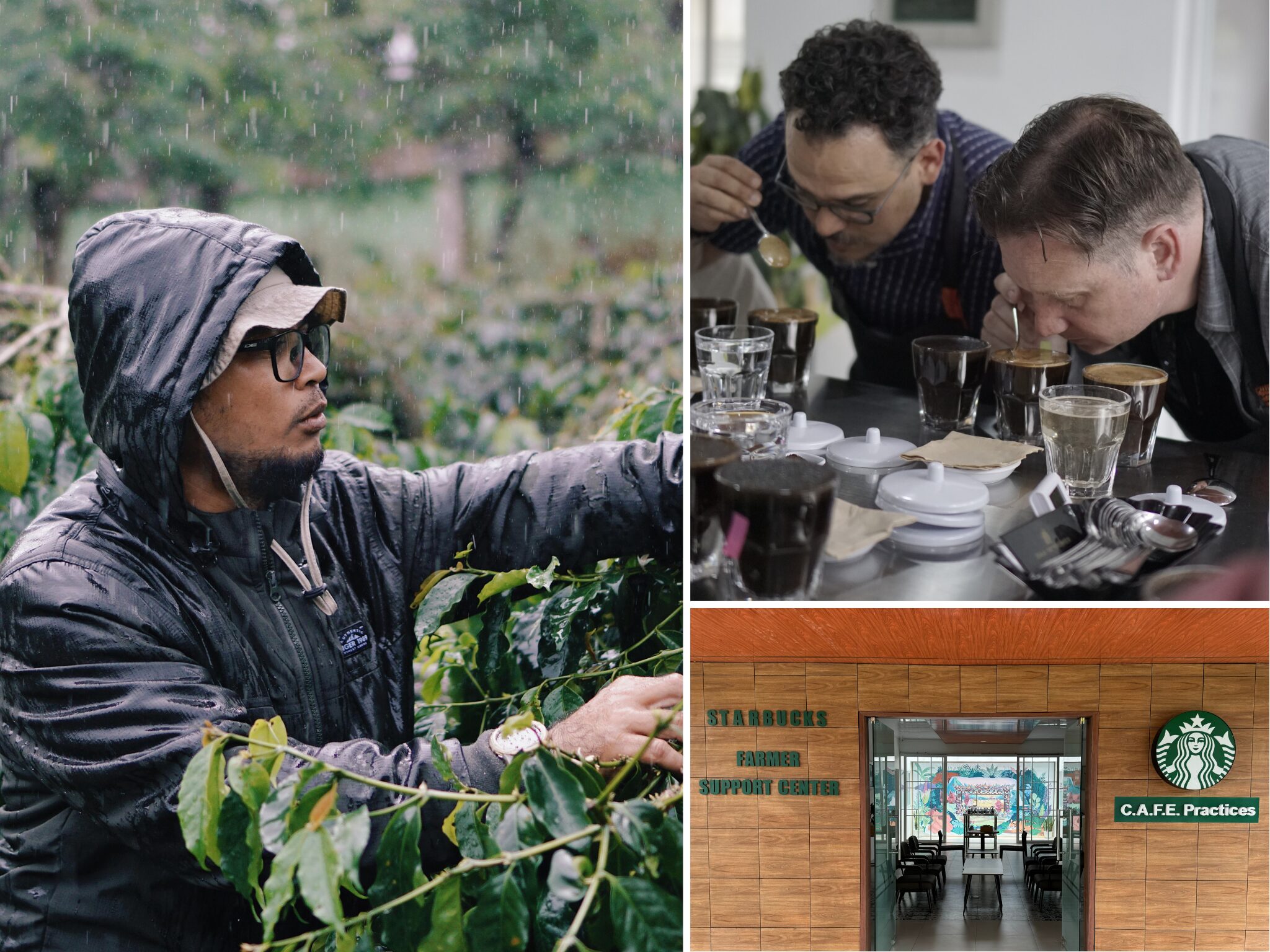Inside Starbucks’ Farmer Support Centers to Secure the Future of Coffee
12 Mins Read
Starbucks buys 3% of all coffee in the world – so its responsibility to safeguard the future of the industry, which is being ravaged by climate change, can’t be understated. Here’s how it’s helping coffee farmers adapt and thrive.
It’s been nearly a decade since the world’s largest coffee company opened its Farmer Support Centre in North Sumatra, a three-hour drive from the region’s capital, Medan. It was the company’s eighth such facility – there are a total of 10 spread across the world – where its agronomists work with local farmers to find solutions to climate change, enhance the yield and quality of their crops, and increase profitability.
The FSC in Sumatra supports farming communities across the Aceh province, alongside other regions like Flores, Sulawesi, west and east Java, and Bali. If you’ve ever been to a Starbucks Reserve store, you may have seen coffees from these origins served at the bar. The company has been sourcing its coffee from Sumatra ever since it was founded in 1971, and is today the largest buyer of coffee in Indonesia, which itself is the world’s fourth-largest producer of the crop.
But coffee faces a difficult future, with climate change and extreme weather events affecting yields, quality and prices, and endangering 60% of all coffee species grown. This will affect not just smallholder farms and coffee suppliers, but even speciality coffee roasters and big chains like Starbucks, which purchases 3% of the world’s coffee.
There’s a very real possibility that 60 years from now, arabica coffee may not exist – or at least not in its current form anyway. Something needs to change, and for a company that exclusively deals with arabica, Starbucks knows that. I had the chance to visit the FSC in North Sumatra earlier this month, where I learnt exactly what the coffee chain is doing to secure the industry’s future. The answer? A heck of a lot.
Shifting plantation patterns for greater productivity
As you enter the FSC, you’re greeted with a gorgeous piece of artwork encapsulating the region’s women-led coffee community, created by Australian multidisciplinary artist Leia Sidery. There are three layers: one shows a mother and a child looking out at the busy women who work a coffee farm, another pans back over the surrounding landscape, and the outermost layer pays homage to the region’s rainforest and biodiversity.
Overlooking the painting is a long table set up with tons of coffee and cups for a tasting session (cupping, as it’s called in the industry). Outside, it’s all green, with model coffee plantations, shade trees and cash crops, a greenhouse, and a barn with farm animals all thriving in the ecosystem.
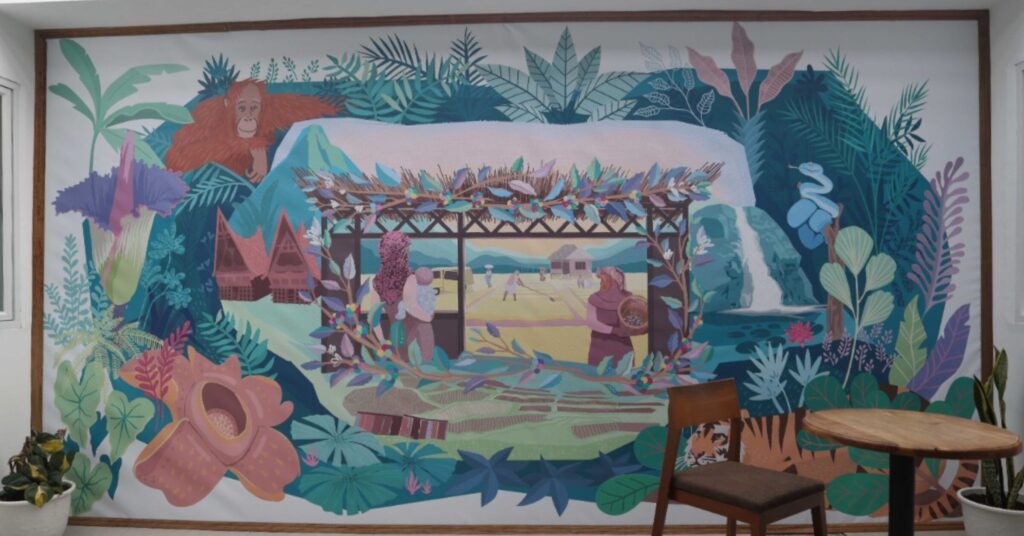
Indonesia, a former Dutch colony, has adopted its coffee plantation system from the Netherlands. But this is labour-intensive, and Starbucks agronomists are promoting Central American farm systems, which feature high-density plantations dotted with shade trees in an intercropping pattern that protects the forest, allows for higher production, and adapts to the local climate.
This is why it’s not just coffee trees you see in its facility – there’s cinnamon, areca nuts, betel leaf and vanilla too. In the old and existing system, the coffee trees are quite short, but this leaves a lot of empty space. To make things more compact and efficient, Starbucks is introducing taller trees and shifting the pattern from squares to rows – whether those are parallel or in a zig-zag pattern.
This allows farmers to grow considerably more trees. A local farmer who is part of Starbucks’ network tells us that after changing plantation patterns to the one recommended by the FSC, the number of trees on her farm tripled. She has already seen her yield double, and expects more trees to begin producing next year. Intercropping also allows farmers to grow other cash crops like cabbage, potatoes, aubergines and chillies as they wait for the coffee trees to mature or cherries to harvest, providing them with an additional source of income.
Another measure Starbucks has taken to adapt to climate change is the introduction of greenhouses. After coffee cherries are picked, they need to be dried. While this was not a problem years ago in the dry season, more erratic rainfall patterns have made this a tricky process, often damaging the coffee cherries and leaving them open to defects. Greenhouses, though, can retain heat for drying coffee, mitigating the impact of irregular rainfall.
Relying on model farms and open-source agronomy
To help smallholder farmers see the benefits of these modern farming practices, Starbucks relies on what it calls “model farms”, which act as a benchmark for effective coffee production in their specific regions. Elliot Bentzen, director of trade and traffic at Starbucks, outlines that theoretical education can only go so far. “There’s no better lesson than going to the field and seeing it firsthand,” he explains.
The best way to set up a model farm, he adds, is to find local producers who are willing to change and adapt their practices, and help them equip their farm with the best system possible. The idea is for neighbouring farmers to see it for themselves and become inspired by the efficiency, yield and income potential.
But this isn’t just for farmers who sell to Starbucks, or are part of its Coffee and Farmer Equity (CAFE) Practices network – this is its own verification programme for ethical, transparent and sustainable coffee production. The company promotes the principle of open-source agronomy, enabling knowledge-sharing and enlisting support for any farmer who wants it. “At the end of the day, without farmers, without coffee, Starbucks wouldn’t be here,” says Bentzen. “So we need them, and we want to make sure they’re sustainable and there is a future.”
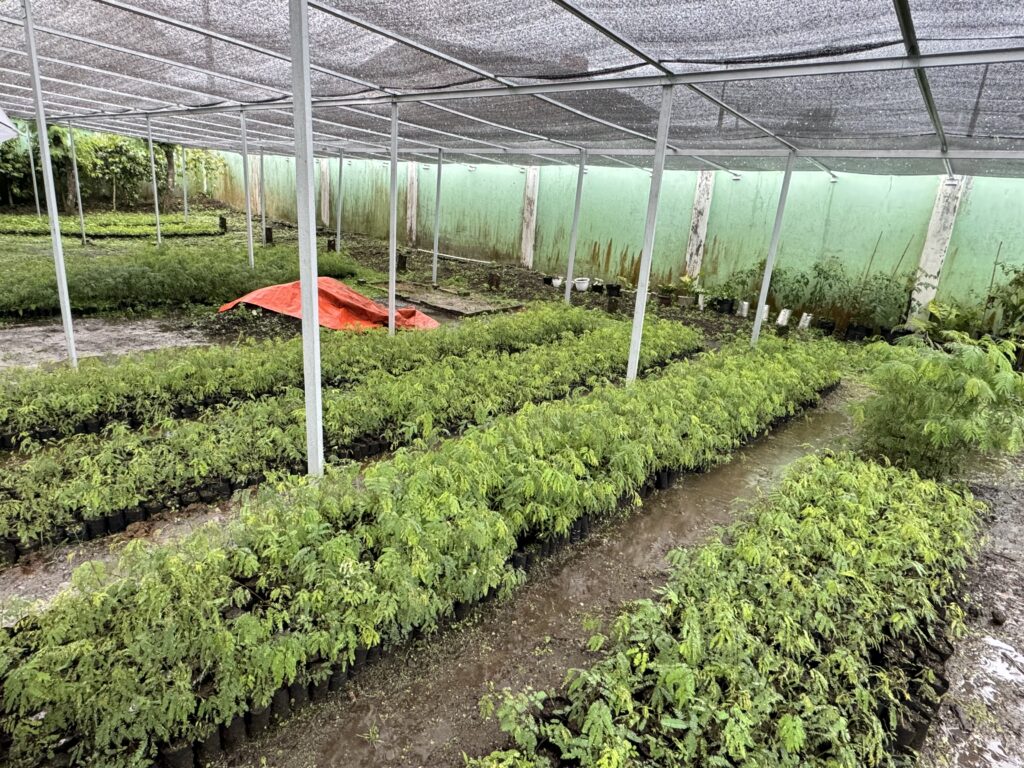
As part of this industry-wide approach, it is offering seedlings of shade trees to farmers for free, and has donated 560,000 coffee tree seeds to farming communities across Indonesia. Additionally, it has committed to providing 100 million climate-resilient coffee trees globally by 2025 – as of February, this was at 80 million, and the company remains on track for this goal. This strategy helps Starbucks expand the implementation of CAFE Practices too.
Bentzen explains that while all of the coffee sold by Starbucks is ethically sourced (since it can be traced back to its origin), 99% is verified by CAFE Practices. The remaining 1% involves farmers who aren’t yet verified by the programme, but can be integrated over a longer period. Because their supply chains can be complex, Starbucks offers to buy their harvests to help them convert their practices.
Climate change also has an effect on the price of coffee – from what farmers are paid for their crops to what consumers pay for their lattes. Known as ‘C price’ in the trade, these have been volatile over the last decade. While farmers are currently earning a good premium, the cost structure is cyclical. Starbucks pays farmers differentials based on the C price on the day of delivery, instead of a fixed rate.
But even when shelling out higher differentials, the company realised that farmers were often getting paid below the cost of production – essentially, they’re making a loss. To bridge that gap, it initiated an Emergency Relief Fund, paying an extra $20M to support farmers, highlighting its commitment to the coffee community.
Novel futureproof coffee varietals to fight leaf rust
Given that arabica is an endangered species of coffee, I ask Bentzen if Starbucks would ever consider using robusta, the other main species. Robusta contains twice the caffeine content, can be grown at lower altitudes and thus in larger quantities, and is cheaper to produce – but that’s also why it’s attached to an inferior reputation that promotes quantity over quality.
While he is adamant that the conversation shouldn’t be as binary as “arabica good, robusta bad”, and is more just about taste preferences, he says: “I would hope that we would not need to go to Robusta one day, because I’m positive about the future of arabica.”

Last year, Starbucks announced it had developed six “climate-resilient” arabica varietals – and as an extension of its open-source approach, it would be giving these breeds to suppliers and farmers for free. Developed over 10 years, the company is exploring what varietals can sustain harder climates, with efforts being led from its Hacienda Alsacia farm in Costa Rica.
“Coffee usually takes about three years to produce a cherry. It’s an investment, you have to plant a tree, and you’re not going to get any income from that tree for three years,” explains Bentzen. “Well, how can we change that? How can we get new trees that can start producing after 18 months?”
One of the most devastating diseases affecting coffee is leaf rust, a type of fungus that decimates crops and has previously become an epidemic that has strained the global supply. There’s a reason why Sri Lanka, which used to be the third-largest producer of coffee in the late 19th century, is now known for tea – and it’s leaf rust.
While the disease usually affected crops at the bottom of farms, climate change has meant leaf rust has begun creeping up mountains, and that is a problem. The fungus mutates as well, so trees that are resistant today may not be so a decade later. Bentzen describes arabica as a finicky species susceptible to disease and pests, which is why Starbucks is experimenting with these new varietals. It’s also exploring arabica trees that need less water and fewer fertilisers.
“Climate change is an issue. We’re all aware of it, and we have to face it. It’s something that’s very dear and near to Starbucks’ heart,” says Bentzen. “We’re going to have to change the way we do things… I’m positive about the future that we have the technology, resources, engineers, agronomists and researchers to do the work to make sure we have coffee in the future.”
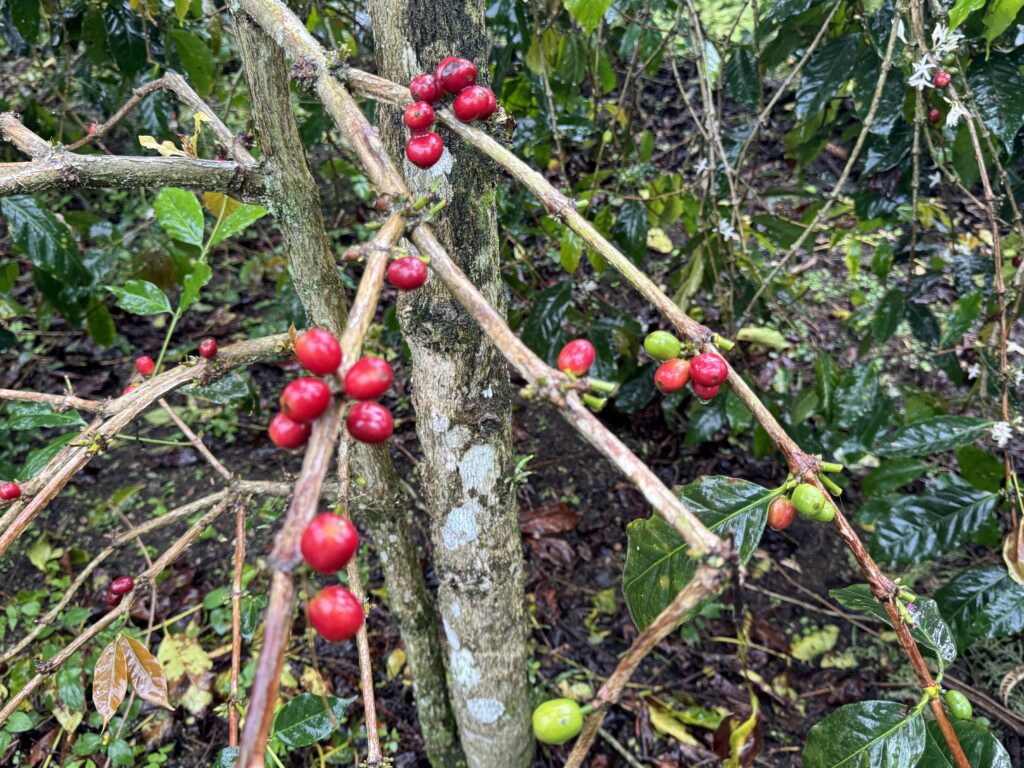
However, any new varietal would also need to pass the palate test – if it doesn’t taste good, there’s no point. “If the quality is not there, we believe that is not sustainable,” explains Sergio Alvarez, Starbucks’ global coffee development lead. The company is currently conducting trials with producers to see how these new seeds fair – if the climate resistance and flavour quality are indeed what’s expected, you may see these new varietals make their way onto the Starbucks menu.
Inspiring the next generation of farmers
Starbucks’ agronomists in Indonesia are also hoping to educate farmers about the importance of pruning the shade trees, which prevents volatility and enables stable production. It also makes picking the coffee cherries off the trees much easier.
But what does it do with the waste generated? There’s a circularity aspect at play here, as the pruned bits are used as feed for the goats, sheep and chickens at the FSC, which in turn produce manure for the crops. Starbucks calls this “integrated farming”, and confirms that the animals aren’t raised for any other purposes but to support the farm.
One issue facing the industry transcends coffee itself. The agricultural sector is dealing with an ageing population – in Indonesia, 80% of farmers are aged 45 and over, despite the median age of the overall population being under 30. Concerns about the future of food are growing as younger generations become dissuaded from farming in search of an urban livelihood.
Bentzen explains that, usually, if younger generations don’t want to get into farming, a neighbouring farmer would buy the farm. And since most coffee is smallholder-farmed, buying these plantations would only help them. But, if there’s a complete shift and nobody’s taking over these fields, that’s an issue. He notes that people shouldn’t feel obliged to farm, of course, but it’s important to show that it could mean a happy life as well. “It shouldn’t be a burden to take over a coffee farm, it should be an opportunity,” he says.

The local farmer we speak to says that’s exactly what she’s done with her daughter, who has been enlightened by the productivity and income potential of coffee production. But she adds that the FSC were key in helping her get here, before which there was no guidance on how to adapt to extreme weather – heavy rainfall meant tree leaves would fall and flowers that were meant to blossom wouldn’t survive. Apart from the agronomic expertise, Starbucks also provided her with seedlings for shade trees, which helped improve yields and income.
Deforestation, beanless coffee and cascara on Starbucks’ radar
In the food tech world, some startups are coming up with solutions like beanless coffee, which entails using agricultural sidestreams and other ingredients that are fermented and processed in a way that replicates the flavour of coffee. It’s essentially the plant-based meat of the coffee world.
The benefits are obvious – you’re saving a lot of land, water and emissions, plus using up surplus food to combat waste. However, beanless coffee also has its critics, particularly within the coffee community, which has raised concerns about what this would mean for the 125 million people who depend on coffee for their livelihoods.
While Alvarez recognises the climate impact and says Starbucks is looking closely at this industry, it is still a coffee company. He also questioned the amount of resources and monoculture required to produce alternatives that require byproducts. “Ultimately, the value of coffee is not to produce a liquid that tastes like coffee, but what happens from the tree all the way down to the cup and what happens in between,” he suggests. “So I don’t know if I’d ever be enamoured or thrilled or curious enough to be like: ‘Okay, some scientists boiled it down to a cup of coffee!’”
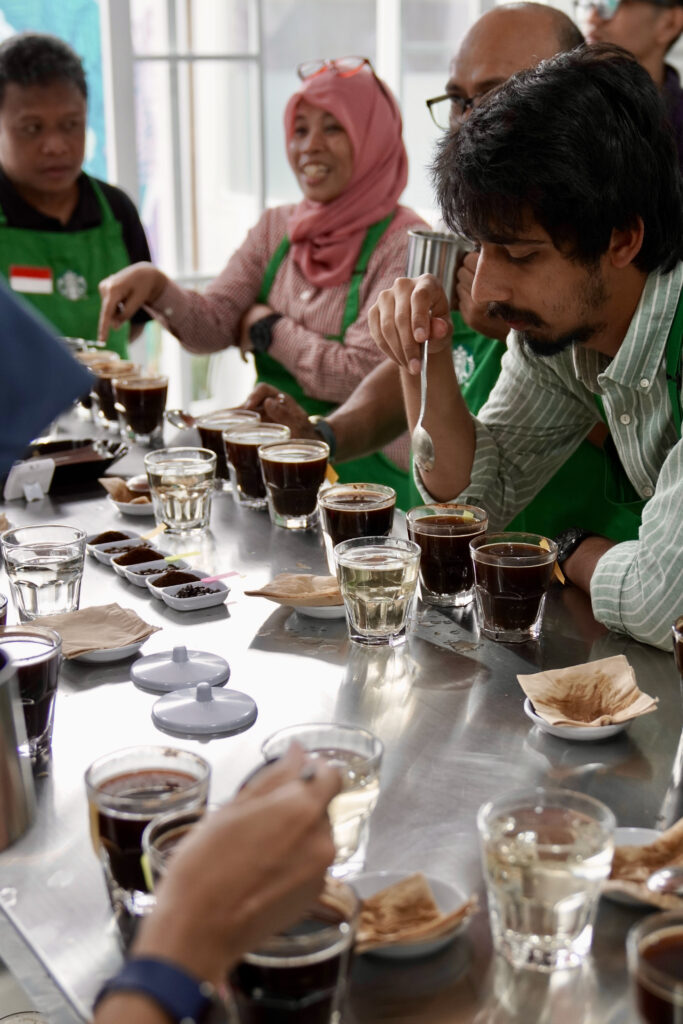
Some other startups are working on cell-based coffee or developing perennial coffee crops using molecular biology and crop genetics. Unlike bean-free alternatives, this really is coffee, just produced in a different way. Both Alvarez and Bentzen recognise the potential and say they’re curious to try it – however, they highlight that it bypasses all the communities they’re helping, and add that a lot of the work they’re doing would no longer exist. They reiterate that Starbucks will always focus on farmers and coffee communities, but again acknowledge addressing climate change and supply chain impacts is vital.
When coffee beans are separated from their cherries, the outer husks (called cascara) are usually discarded. But these can be brewed into a fruity tea, and are sometimes sold by specialty coffee companies and local producers. Starbucks, which has previously used Indian cherries for a cascara syrup, currently sources some from Colombia for a tea blend in its Tokyo roastery – and Alvarez says the chain is exploring if it can introduce this at scale, which would amp up its food waste credentials too.
But there is a more urgent issue for Starbucks to contend with. Starting next year, all deforestation-linked coffee will be banned in the EU (alongside cocoa and other crops). Similar regulations are expected in the US and the UK (though coffee isn’t included in the latter, despite calls from campaigners to add the crop to the list).
Bentzen recognises that this is a trend that will only grow, and eventually become part of legislator frameworks across the world. “It’s the right thing to do, we’re totally on board,” he says. But he adds that there’s a lot of grey area in the EU Deforestation Regulation, which doesn’t properly outline the changes that need to be implemented. Businesses have to prove every farm is deforestation-free, and the EU wants GPS coordinates for traceability, but he argues that these changes have happened too quickly and left companies scrambling and anxious.
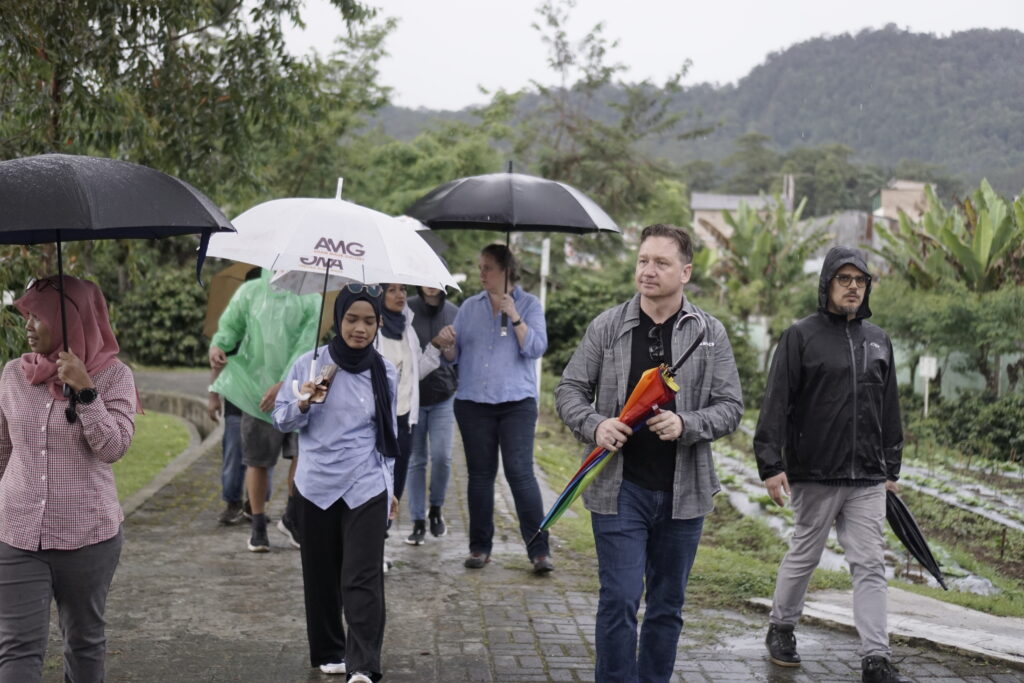
“We’re freaking out a bit. Everyone is freaking out,” Bentzen says, suggesting that the EU “bit off more than it can chew”. But this is a major priority for Starbucks now. “We’re going to do everything we can to be compliant.”
It highlights the breadth of challenges being faced by the coffee industry – whether that’s climate change, ageing farmers, crop diseases, volatile prices, or legislative pressure. As Alvarez puts it. “We have to educate customers and partners that we cannot take coffee for granted.”

